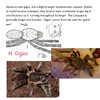Paul Osullivan
Arachnosquire
- Joined
- Dec 18, 2019
- Messages
- 101
To be honest, if a spider has these Four VERY UNIQUE/ KEY features (attatched) that's described only to H. HERCULES by Pocock and are NOT seen and described for any other Hysterocrates. You have to think this must be it, or at least a close relative to it and indeed the type specimen? The chances of a spider having these features on top of all the others described like mine (and possibly a few others I have seen) and not for it to be it is near impossible. It should be labled at the very least - H. Hercules (regional variation) or similar as it most closely matches this description than to the others (e.g gigas, crassipes etc).
There are also other sources that have H. Hercules pictures in the "Common Hysterocrates features" file on this shared folder and the file "key Hercules features" explains more unique features to H. Hercules.. thanks I hope you find this interesting ..

Below the four "key features" attachments are different "hercules" from different sources and I would have to agree for them all to be H. Hercules from the unique features seen.. Surely one or all of these had to be labelled "hercules" from a knowledgable expert and maybe was compared to the type specimen and would be "IT". Though with the many unique features of H. Hercules, It didn't need to be compared, as the many unique features were present on the same spider and it was then a case of finding out where it came from and agreeing that all of Pocock's H. Hercules descriptive features being present on the same spider..
Hey all, I have finished prity much everything on the online drive. Including new files "Korean Hysterocrates" and "Whitey's herc compared to laticeps" this goes through in detail some common "hercules" look alikes and how to see the differences in them.
Please take a good look through those and familiarise with all the details. This will make the "Please Read" files easier to grasp.
I hope you will take the time to look through all of it and I will look forward to anything you may want to add or ask about the research.
Thanks,
Paul O'Sullivan
There are also other sources that have H. Hercules pictures in the "Common Hysterocrates features" file on this shared folder and the file "key Hercules features" explains more unique features to H. Hercules.. thanks I hope you find this interesting ..

Below the four "key features" attachments are different "hercules" from different sources and I would have to agree for them all to be H. Hercules from the unique features seen.. Surely one or all of these had to be labelled "hercules" from a knowledgable expert and maybe was compared to the type specimen and would be "IT". Though with the many unique features of H. Hercules, It didn't need to be compared, as the many unique features were present on the same spider and it was then a case of finding out where it came from and agreeing that all of Pocock's H. Hercules descriptive features being present on the same spider..
Hey all, I have finished prity much everything on the online drive. Including new files "Korean Hysterocrates" and "Whitey's herc compared to laticeps" this goes through in detail some common "hercules" look alikes and how to see the differences in them.
Please take a good look through those and familiarise with all the details. This will make the "Please Read" files easier to grasp.
I hope you will take the time to look through all of it and I will look forward to anything you may want to add or ask about the research.
Thanks,
Paul O'Sullivan
Attachments
-
552.2 KB Views: 180
-
146.4 KB Views: 169
-
223.1 KB Views: 133
-
207.3 KB Views: 136
Last edited by a moderator:
























































